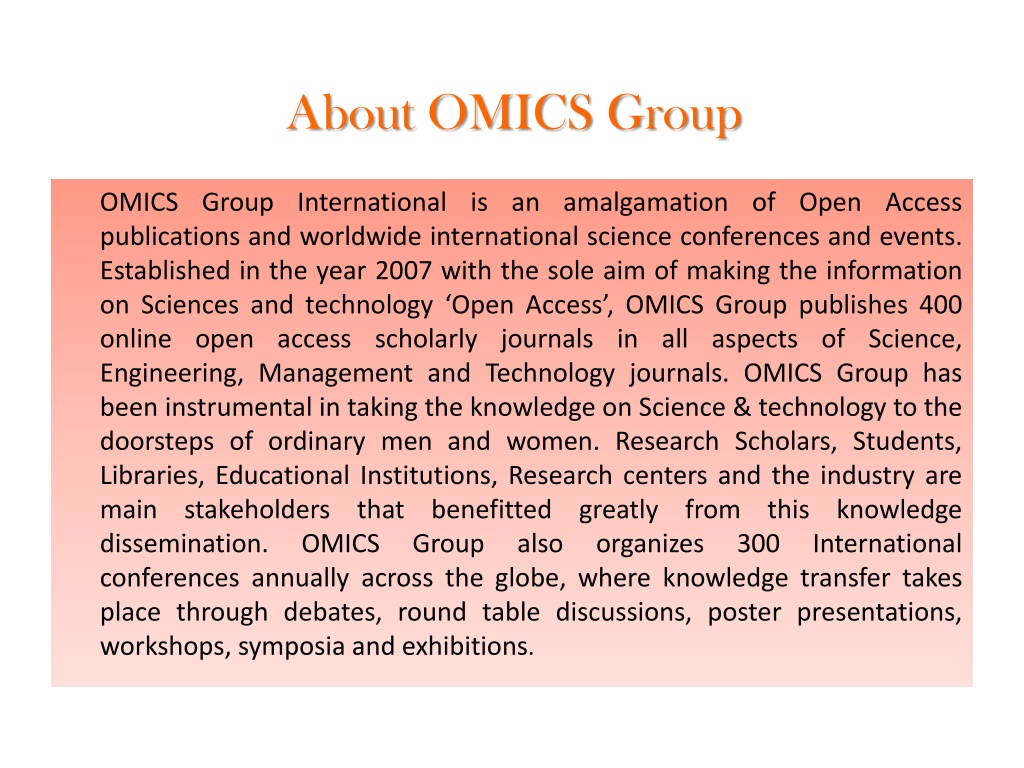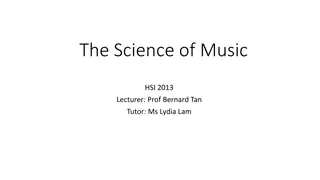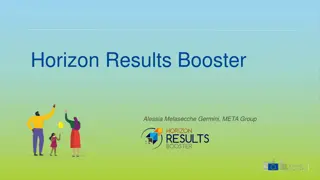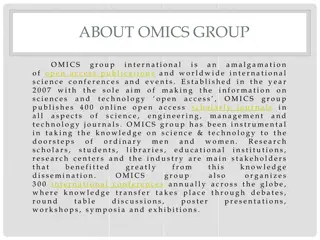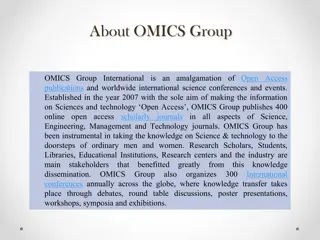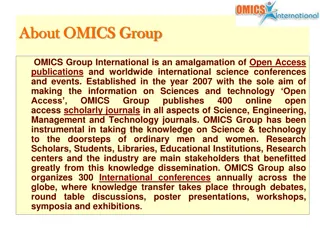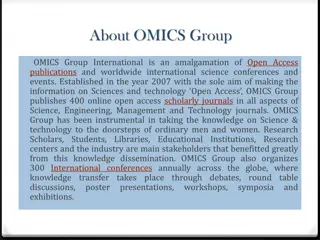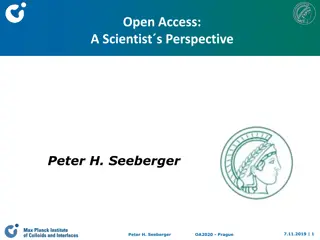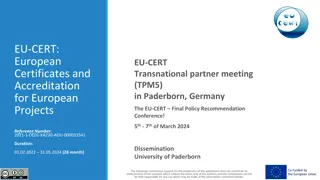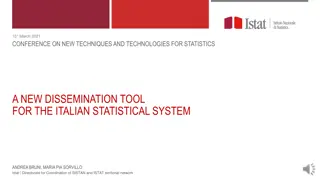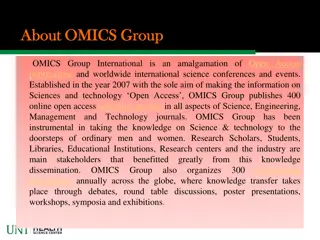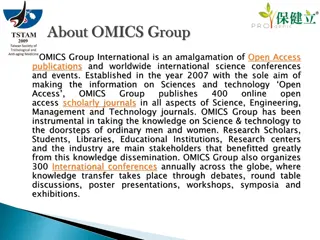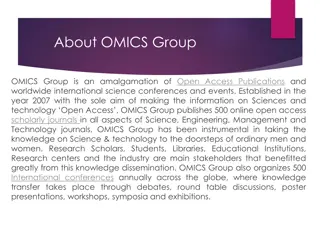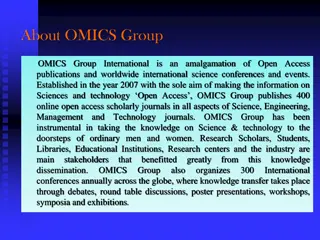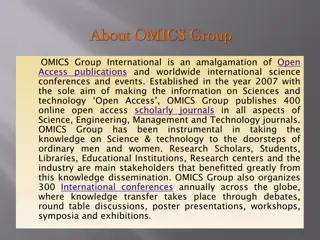Exploring the Impact of OMICS Group in Science and Technology Dissemination
OMICS Group International, founded in 2007, is dedicated to promoting Open Access in science and technology through 400 scholarly journals and 300 annual conferences globally. With a focus on knowledge transfer and accessibility, OMICS Group serves diverse stakeholders, including research scholars, students, and industry professionals. The organization's contribution to advancements in various fields is evident through publications, events, and collaboration with scientific associations. Key initiatives include the facilitation of research dissemination, hosting debates, workshops, and symposia, creating a platform for the exchange of ideas and innovation.
- Science dissemination
- Technology accessibility
- Scholarly journals
- Global conferences
- Knowledge transfer
Download Presentation

Please find below an Image/Link to download the presentation.
The content on the website is provided AS IS for your information and personal use only. It may not be sold, licensed, or shared on other websites without obtaining consent from the author. Download presentation by click this link. If you encounter any issues during the download, it is possible that the publisher has removed the file from their server.
E N D
Presentation Transcript
About OMICS Group OMICS Group International is an amalgamation of Open Access publications and worldwide international science conferences and events. Established in the year 2007 with the sole aim of making the information on Sciences and technology Open Access , OMICS Group publishes 400 online open access scholarly journals in all aspects of Science, Engineering, Management and Technology journals. OMICS Group has been instrumental in taking the knowledge on Science & technology to the doorsteps of ordinary men and women. Research Scholars, Students, Libraries, Educational Institutions, Research centers and the industry are main stakeholders that benefitted dissemination. OMICS Group also conferences annually across the globe, where knowledge transfer takes place through debates, round table discussions, poster presentations, workshops, symposia and exhibitions. greatly organizes from this knowledge International 300
About OMICS Group Conferences OMICS Group International is a pioneer and leading science event organizer, which publishes around 400 open access journals and conducts over 300 Medical, Clinical, Engineering, Life Sciences, Phrama scientific conferences all over the globe annually with the support of more than 1000 scientific associations and 30,000 editorial board members and 3.5 million followers to its credit. OMICS Group has organized 500 conferences, workshops and national symposiums across the major cities including San Francisco, Las Vegas, San Antonio, Omaha, Orlando, Philadelphia, Baltimore, United Kingdom, Valencia, Dubai, Beijing, Hyderabad, Bengaluru and Mumbai. Raleigh, Santa Clara, Chicago,
Proton conduction in tin phosphates and their application to electrochemical devices Nagoya University Graduate School of Environmental Studies Masahiro Nagao
Contents Development of proton conductor Application to the fuel cell Application to the NOx reduction reactor Application to the sensor Application to the capacitor 4
Applications using ionic conductors Electrical charges are transported as the form of ions. Fuel Cell Membrane reactor Battery Gas sensor A H2 AH Li+ H+ OH- CO3- O2- H+ O2- (oC) 0 Ionic conductive liquids, Polymers, Ionic-liquids 200 B L A N K 400 600 Molten salts Ionic conductive ceramics 1000 6
Ionic conductors 700 500 300 200 100 50 0 Sn0.9In0.1P2O7 LSGM Nafion -1 BCY Log conductivity / S cm-1 NH4PO3 -2 ZrO2/PDMS/PWA Ba2In2O5 -3 GDC YSZ -4 CsH2PO4 -5 Sr-doped LaPO4 CsHSO4 -6 -7 0.5 1 1.5 2 2.5 3 3.5 1000 T-1 / K-1 SnP2O7 1) Solid electrolyte 2) Conductive under unhumidified conditions 3) Stable under reducing conditions 7
Conductivity of In3+ doped SnP2O7 0.2 Scm-1@200 C Sn0.80In0.20P2O7 Sn0.90In0.10P2O7 Sn0.95In0.05P2O7 Sn0.97In0.03P2O7 --- SnP2O7 0.2 Conductivity / S cm-1 0.1 0.0 1.5 2.0 1000T-1/ K-1 2.5 3.0 8
Charge carrier Conductivity ratio -0.4 H2O+ / D2O+ = 1.32 (nearly 2) Log conductivity / S cm-1 -0.6 -0.8 Conducting ions H3O+, H+ H H2O atmosphere D2O atmosphere D -1.0 Mass ratio MH3O+ MD3O+ = 19 22 MH+ MD+ -1.2 2.0 2.4 2.8 3.2 3.6 = 1 2 1000T-1/ K-1 vehicle mechanism Grotthuss mechanism 9
ionic transport number at 250oC 80 70 60 50 OCV / mV 40 30 20 Theoretical EMF ------ theoretical -- -- measured OCV 10 0 0.01 0.1 1 PH2 / atm H2 (1 atm), Pt/C Sn0.9In0.1P2O7 Pt/C, H2+Ar (x atm) Ionic transport number : 0.97 pure ionic conductor in H2 atmosphere 10
introduction of protons Increase of proton concentration by the doping Sn4+ <= In3+ + H+ Interaction with water vapor Sn4+ In3+ Sn4+ Sn4+ In3+ In3+ H+ H+ Sn4+Sn4+ In3+ H+ H+ Sn4+ H+ Sn4+ Sn4+ H+ In3+ Point defection (1) Substitution of In3+ for Sn4+ increase the h concentration Sn4+ In3+ + h (2) H H+ + is introduced according to the interaction of H2O with h H2O (g)+ h Hi+ + O2(g) 11
Application to the fuel cell 2 2 12
In3+ doping into Sn4+ SnO2 + In2O3 +H3PO4 + H2O stirred and heated at 300 C Slurry with high viscosity solid state reaction at 650 Cfor 2.5 hours In3+doped SnP2O7 powder *P / (Sn + In) ratio = 2.0 (determined by XRF) uniaxial hydrostatic press at 2,000kgcm-2 pressed pellet 13
application to the fuel cell 100 C 200 C 600 C 1000 C 0 C Ionic conductor GAP NafionTM H3PO4 Y-stabilized ZrO2 v.s. PEFC Platinum catalyst CO poisoning Smooth electrode reaction Highly purified and high- pressured H2 storage Extreme humidification Variety of fuels (hydrocarbons, alcohols, ethers) v.s. SOFC Transition-metal(oxide) catalyst Cheap structural materials Extreme humidification Suitable for large size Careful start--stop operation Intermediate temperature 14
Fuel cell performance (temperature dependence) Electrolyte thickness: 1.0 mm Fuel: Hydrogen (30cc) 1000 160 250 900 140 . 800 200 300 120 . 700 Power density / mW cm-2 100 Cell voltage / mV 600 150 500 80 400 60 300 40 200 100 20 100 0 0 0 100 200 300 400 500 600 Current density / mA cm-2 15
Fuel cell performance (dependence of electrolyte thickness) Temperature: 250 C Fuel: Hydrogen (30cc) 1000 300 Power density / mW cm-2 250 800 Thickness = 0.35 mm Cell voltage / mV 200 600 = 0.6 mm 150 400 100 = 1.0 mm 200 50 0 0 0 200 400 600 800 1000 Current density / mA cm-2 16
Stability test 1000 800 Cell voltage / mV 600 700 mV 400 150 200 250 300 200 350 0 0 2 4 6 8 10 Time / hour
CO tolerance on fuel cell performance High tolerance and good stability toward CO
Other works PAPERS Cathode (ORR: 1/2O2 + 2H+ + 2e- H2O) Activation of ORR Increase of TPB by the composite of electrolyte and catalyst High dispersion of catalyst FUEL CELLS 10, 798-803, 2010 ELECTROCHEM. SOLID-STATE LETT. 12, B1-B4, 2009 Anode HOR: H2 2H+ + 2e- non-platinum catalyst Mo2C catalyst SOLID STATE IONICS179, 1446-1449, 2008 J. ELECTROCHEM. SOC. 154, B53-B56, 2007 Electrolyte decrease of resistance Thin film by using binder JOURNAL OF POWER SOURCES 196, 6042-6047, 2011 ELECTROCHIMICA ACTA 55 8371-8375, 2010 ELECTROCHEM. SOLID-STATE LETT. 13, B8-B10, 2010 Fuel Variety Electrochemically active gas or liquid methane, ethane, propane, butane, dimethyl ether methanol, (ethanol) CHEM. COMMUN. 47, 5292-5294, 2011 Angew. Chem. Int. Ed.47, 7841-7844, 2008 J. ELECTROCHEM SOC. 155, B92-B95, 2008 19
Other electrochemical devices Application 1: Fuel cell Application 3: Gas sensor Application 2: Reactor NO2 N2 NO electro meter galvanostat Electro meter N2 H+ 2. Urea SCR selective catalytic reduction by urea 1. Three-way catalyst CO2 (NH2)2CO + H2O H2O Urea storage tank, infrastructure for urea supply, ammonia slip CO HC CO2 NO N2 NO2 H2O catalyst NO N2 Catalyst support NH3 Urea SCR (NH2)2CO + H2O 2NH3 +CO2 4NO + 4NH3 + O2 4N2 + 6H2O Catalyst support *only for stoichiometric ratio
New concept for NOx Reduction Reactor Fuel cell H2O H2 galvanostat galvanostat N2 H2O O2 NO Electrochemical reduction 2H2O 4H+ + 2O2 + 4e- 2NO + 4H+ + 4e- N2 + 2H2O
NOx reduction by currentNOx conc. changes in outlet Temperature = 250 C O2 concentration = 5% 820 0mA 0mA Concentration of NO / ppm 800 10mA 780 20mA 760 30mA 740 40mA 720 50mA 700 680 0 10 20 30 40 50 60 Time / min H2O 2H+ + 1/2O2 + 2e- Counter NO + 2H+ + 2e- 1/2N2 + H2O 23 Working
Current efficiency Temperature = 250 C O2 concentration = 5% 30 6 2% O2 3% 5% 7% 9% 25 5 Ba Pt=4 1 Pt/C Current efficiency / % 20 4 Conversion / % 15 3 10 2 5 1 0 0 0 10 Current / mA 20 30 0% 2% 4% 6% 8% 10% O2 concentration / % 24
NOx reduction by alternating currentNOx conc. changes in outlet Temperature = 150 C Frequency = 0.01 Hz 25
Conclusion Sn0.9In0.1P2O7 showed high conductivity of 0.2 S cm-1 at 200--250 in unhumidified conditions. A fuel cell using Sn0.9In0.1P2O7 as the electrolyte (0.35 mm thick) showed high power density of 264 mW cm-2 at 250 in unhumidified conditions and had good stability for discharge properties below 350 . The NOx reactor using Sn0.9In0.1P2O7 as the electrolyte showed a high conversion of NOx to nitrogen. The NOx were reduced by using alternating current at 0.01 Hz. Partial of this work was supported by JSPS KAKENHI Grant Number 25870308. Thank you for your attention.
Let Us Meet Again We welcome you all to our future conferences of OMICS Group International Please Visit: http://materialsscience.conferenceseries.com/ Contact us at materialsscience.conference@omicsgroup.us materialsscience@omicsgroup.com
